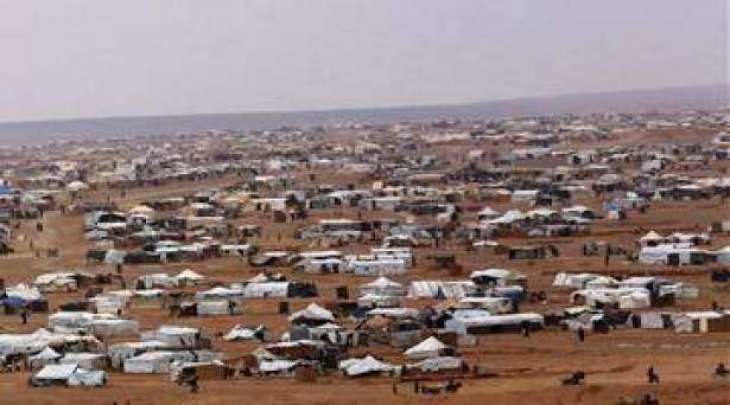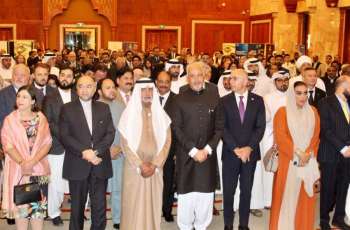The resettlement of the remaining residents of the Rukban refugee camp, located within the 55-kilometer (34.1 miles) zone controlled by the United States, near its unauthorized military base in Syria's At Tanf area, is starting on Friday
MOSCOW (Pakistan Point News / Sputnik - 27th September, 2019) The resettlement of the remaining residents of the Rukban refugee camp, located within the 55-kilometer (34.1 miles) zone controlled by the United States, near its unauthorized military base in Syria's At Tanf area, is starting on Friday.Rukban is a Syrian refugee camp located on the Syrian-Jordanian border in the southeastern part of Homs.
Syria's civil war began in 2011, which paved the way for the Islamic State terrorist group (IS, banned in Russia) to expand its influence in the country. Victory over the terrorist organization was eventually declared in late 2017. However, Syrian government troops, with support from the Russian Aerospace Forces, continue to assassinate militants. Recently, finding a political solution to the crisis, as well as the return of refugees and rebuilding the country after the war are all issues that have to come to the forefront.
The Rukban camp was set up on the Syrian-Jordanian border in 2014, after Jordanian authorities closed the border due to security concerns. According to the Russian Foreign Ministry, up to 50,000 people lived in the camp at the end of 2018.
The vast majority of refugees belong to the most vulnerable categories of the population: women, children under five years old, and elderly and disabled people.
According to the Russian Defense Ministry, the camp is managed by a council of illegal armed groups, with the Kuwat Shahid Ahmad al-Abdo militant group as its core.
The militants set up roadblocks inside the 55-kilometer zone around the camp and surrounded the territory with barbed-wire fence. Only Syrians who leave relatives in Rukban as "hostages" are allowed to exit.
According to the Defense Ministry, the humanitarian situation in the Rukban refugee camp is dire. People huddle in shacks without water and electricity and have pit latrines in their homes, and trash is not collected. The problem of providing the camp population with drinking water is acute. There are only two water distribution points, and the water is only drinkable after additional purification and boiling.
The lack of certified medical facilities and qualified personnel in the camp led to a catastrophic situation in the health sector. Many camp residents suffer from skin diseases, the flu, measles, tuberculosis, asthma, and diabetes. There have also been cases of cholera and leprosy.
Children have little chance of survival due to being born in the absence of nutritional and medical care, and in conditions in which infectious diseases flourish. According to relatives of the camp residents, most of those who die daily at Rukban are children under the age of two.
According to the Office of the United Nations High Commissioner for Refugees (UNHCR), some families have been living in Rukban for more than four years. Children born in the camp "do not have any civil documents; they have neither birth certificates nor even birth reports."
According to the Defense Ministry, there are cases in which refugees have fallen into "food slavery" due to a lack of money. The assistance provided by international organizations almost completely ends up in the hands of militants.
Russian military personnel and diplomats have repeatedly pointed out that terrorists from various groups, who are hiding there from the Syrian army, are operating in the Rukban area in the "illegally US-occupied" zone.
According to Russian Defense Ministry spokesman Maj. Gen. Igor Konashenkov, the humanitarian disaster in the Syrian region of At Tanf is artificially maintained by the US side in order to have a constant source of recruits from Rukban for US-controlled militant groups.
The Pentagon and the US-led coalition claim that their allied armed groups in the At Tanf area are fighting IS terrorists.
In order to prevent a humanitarian catastrophe, in February 2019, the Syrian government, with assistance from Russia, opened two humanitarian corridors for internally displaced persons to leave the Rukban refugee camp for their permanent places of residence through checkpoints in the settlements of Jleb and Jabal al-Ghurab.
The head of the Russian Defense Ministry's Center for Syrian Reconciliation, Lt. Gen. Sergei Solomatin, said that at the checkpoints there were epidemic prevention stations; stations for medical examination, eating, resting, finalizing paperwork; as well as a logistics hub and point of departure.
Later, Solomatin made known that the militants operating in the camp area did not allow people to go through mobile checkpoints, intimidating them, and also made a solid earthen berm.
Russian and Syrian authorities also said that the residents of the camp, who expressed a desire to leave its territory, were forced to pay ransom to US-controlled militants, as well as pay for the fuel to go to Jleb, which was not easy to procure due to a progressing fuel crisis.
Russia and Syria also accused the United States of preventing refugees from leaving Rukban. According to the head of the Russian Defense Ministry's Center for Syrian Reconciliation, Maj. Gen. Viktor Kupchishin, the US side did not allow buses to evacuate refugees from the Rukban camp and refused to secure safe movement of a humanitarian column inside the area around its At Tanf base.
Data from the Russian center for Syrian reconciliation shows that, as of September 22, 2019, a total of 17,934 people, including 5,125 women and 8,994 children, left the camp since March 2019.
In that same month, a coordination meeting was held at the Jleb checkpoint to develop step-by-step measures aimed at eliminating the Rukban camp. It was attended by representatives of Russia, Syria, the UNHCR, the Syrian National Reconciliation Committee, the president of the Syrian Arab Red Crescent, as well as by the sheikhs of tribes locked up in Rukban. The US side refused to attend the meeting.
Subsequently, a few more meetings on the elimination of the Rukban camp were held. As part of the implementation of the joint plan to eliminate Rukban, the Syrian government has carried out a whole range of measures to receive its citizens, provide them with everything necessary in temporary accommodation centers, issue simplified documents and deliver them to their permanent places of residence, where everything necessary for a normal life has been prepared.
According to the Russian Defense Ministry, in response to the Russian-Syrian initiative to disperse Rukban, US-controlled armed groups take additional measures to forcibly keep refugees there. The militants formed the so-called local police in the camp and developed a list of prohibited actions and harsh penalties for their violation.
It was expected that the resettlement of the Syrian refugee camp will begin on September 27.
However, according to Col. Gen. Mikhail Mizintsev, the head of Russia's National Center for State Defense Control, the operation is at risk due to a series of provocations organized by US-controlled militants.




